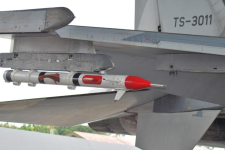We have lagged behind China in technology and production rates of defence equipment,” Indian Air Force (IAF) chief Air Chief Marshal (ACM) Amar Preet Singh said in an assessment vis-a-vis China, while stressing the need for ramping up domestic production of fighter jets by involving the private sector. To another question, he said Russia had promised to deliver the remaining two S-400 air defence regiments next year.
“We have done our analysis. We don’t have a design to go offensive unnecessarily. Only when we are pushed, we will do something… We have our plans in place. One place I can positively say is we are training much better than them. We have exposure much better than them. We get to know… how they train and how many different Air Forces they interact with and how many do we interact with. One people behind the machine, we are way ahead of them,” ACM Singh said addressing the annual press conference ahead of Air Force Day on October 8. “As far as technology is concerned, we may be not so good as of now, we have lagged. We were better than them in technology also sometime ago, but we have lagged in that and we need to catch up. As far as production rates are concerned, we are way behind. We need to catch up. That will happen over a period of time, it cannot happen overnight.”
To a question on the capability of India’s air defence network in the backdrop of the developments between Israel and Iran, the Air Chief said the systems being procured could do similar functions as Israel’s Iron Dome and other systems. “We have a combination of air defence systems which are fairly competent,” he said, noting that India being a very large country needed large numbers of systems and there was need to prioritise vital and priority areas that need to be protected. “Regarding technology, the systems that we have and the systems that we have contracted we have the technology to intercept these missiles,” he added.
The Air Chief said that by 2047 they aimed to have an entire inventory by that time, either produced in India or developed and produced in India. Acknowledging the delay in the Light Combat Aircraft (LCA) Tejas programme with the MK-1A deliveries yet to begin, ACM Singh said their first aim was not to let the fighter aircraft strength go down below 30 squadrons. In this regard, he said Hindustan Aeronautics Limited (HAL) must now stick to its promise of producing 24 aircraft every year to offset the delay. They had set up a third aircraft line in Nashik, it was yet to churn out an aircraft, he noted.
He stressed that private players had to come in to ensure the numbers. “We can’t keep relying on one agency. Even HAL will have limitations,” he stated, given the numbers involved.
The IAF had a tender for 114 fighters jets to be procured under the Multi-Role Fighter Aircraft (MRFA) which had been hugely delayed. “The MRFA is needed as on yesterday”, the Air Chief quipped, underscoring the urgency.
On the indigenous programme lines up, ACM Singh said the LCA-Mk2 was supposed to do its first flight next year October and December 2027 was supposed to be end of research and development for LCA-Mk2. “If these timelines are met and MRFA is signed parallelly we are OK. We are not badly off. But if these timelines are pushed, then we need to look at alternatives.”
Talking of the ground situation in eastern Ladakh, the Air Chief said the situation remained practically the same. Development of infrastructure by China had been “fairly rapid”. “We are also trying to catch up”, he said, adding new airfields at Nyoma and others were coming up and there were plans to utilise the civil infrastructure.
On the Agnipath scheme of recruitment into the armed forces, ACM Singh said the feedback from the ground was very positive. “If we have to absorb more than 25% Agniveers into the force after four years, yes that can be done,” he said, adding a decision on that was for the government to take.
Talking of the impact of ongoing global conflicts on supply chains and maintenance, the Air Chief said in terms of maintaining our aircraft there were issues of supply chains “breaking down” because of these wars. “We have components which come from these regions. So, maintaining those equipment is a challenge, which we have handled very well…,” he stated.












